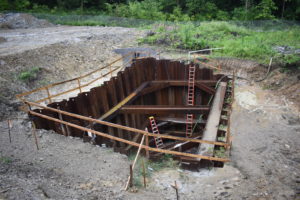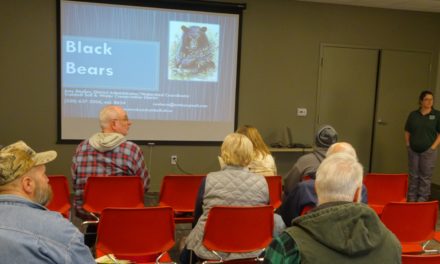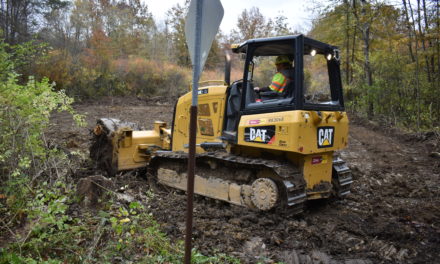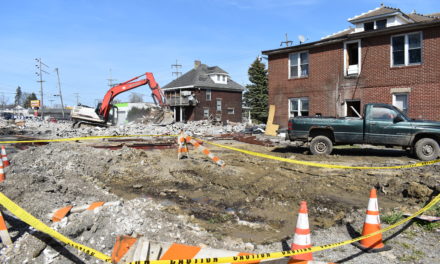
Officials are determining how best to install an influent pump station, the bones of which is shown here.
The expansion and renovation of the Brookfield Waste Water Treatment Plant is focusing on building a large storage basin that will hold excess water to be treated, and the influent pump station, through which
waste water will enter the plant.
These projects require a lot of earth moving and, in the case of the influent pump station, digging down nearly 30 feet. In both cases, officials have found that the soil is not suitable to support the new structures.
“It’s a natural soil. It’s a real gray clay, just kind of soft, and there’s not a lot of bearing capacity to it,” said Cameron Deem of Burgess and Niple Inc, which is overseeing construction for Trumbull County.
County officials are working with project designer Arcadis U.S. Inc., Burgess and Niple, and Thomas
Construction of Grove City, Pa., to come up with plans and shore up the structures. Deem said officials
are looking at installing helical piles — tubes with blades coming out the sides — under the influent building to bear
the weight of the structure.
Scott Verner, interim deputy sanitary engineer, and Dave Armstrong, who operates the Brookfield plant,
said they have run into soil issues at the Brookfield plant during past excavations, and at other county
facility sites.
“Nobody likes to see change orders but, when you get into excavation this deep, it’s very common to run
into poor soil conditions,” Verner said. “There’s gonna be some additional cost associated with it.”
 Pre-construction soil tests did not turn up any problems, he said.
Pre-construction soil tests did not turn up any problems, he said.
The project is being undertaken to modernize the plant and bring it into compliance with Ohio
Environmental Protection Agency requirements. The upgrade will replace the chlorine water sterilization system with an ultraviolet light system, and eliminate the release of partially treated waste water during periods of high inflow because of storm water.
The swirl concentrator, which deals with the partial treatment of waste water, was supposed to be offline
by June 30, but the county has been given a new deadline of Dec. 30. However, the swirl concentrator
cannot be taken offline until the 2.8-million-gallon storage basin – formally known as an equalization
basin – and the influent pump station are online.
“We probably won’t make that milestone,” Verner said of Dec. 30. “It shouldn’t be a couple months past
that.”
EPA officials have received the regular construction project meeting reports so they can monitor progress,
he said.
Overall, officials are happy with the pace of the work, and the diligence of Thomas, which has had only a
handful of days when it wasn’t working because of weather.
The $17 million project is expected to continue into the early months of 2023.
A rate study will be done to determine how much user fees will be raised to pay off the $20 million EPA
loan taken to out to pay for design and construction, Verner said.








